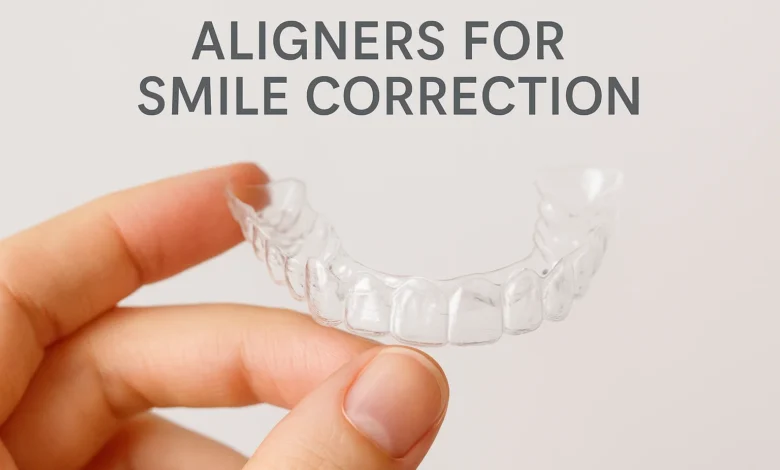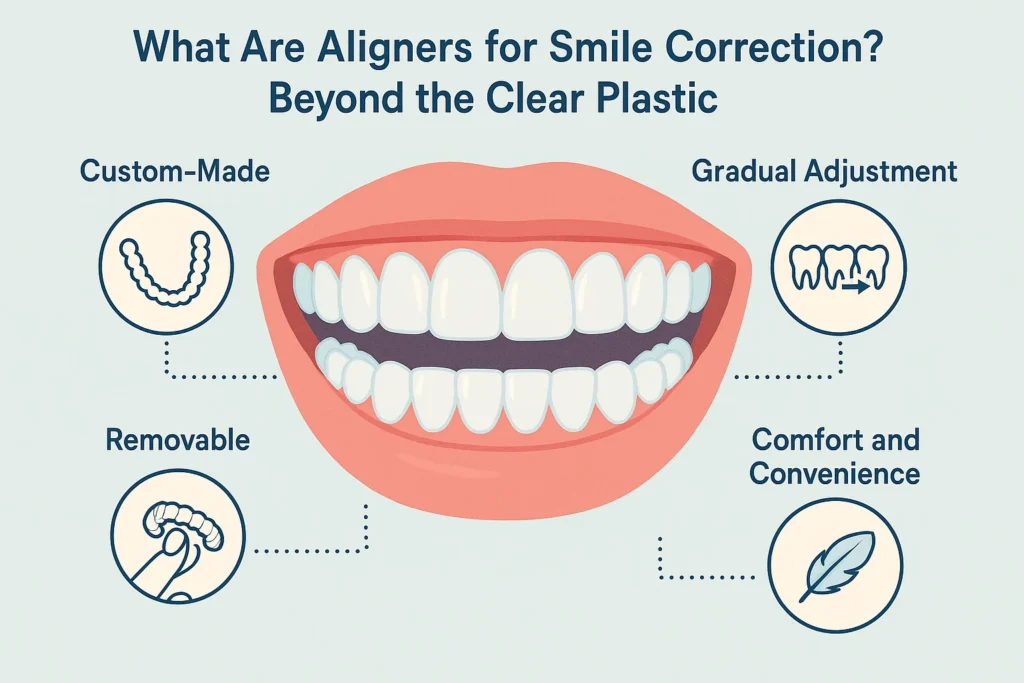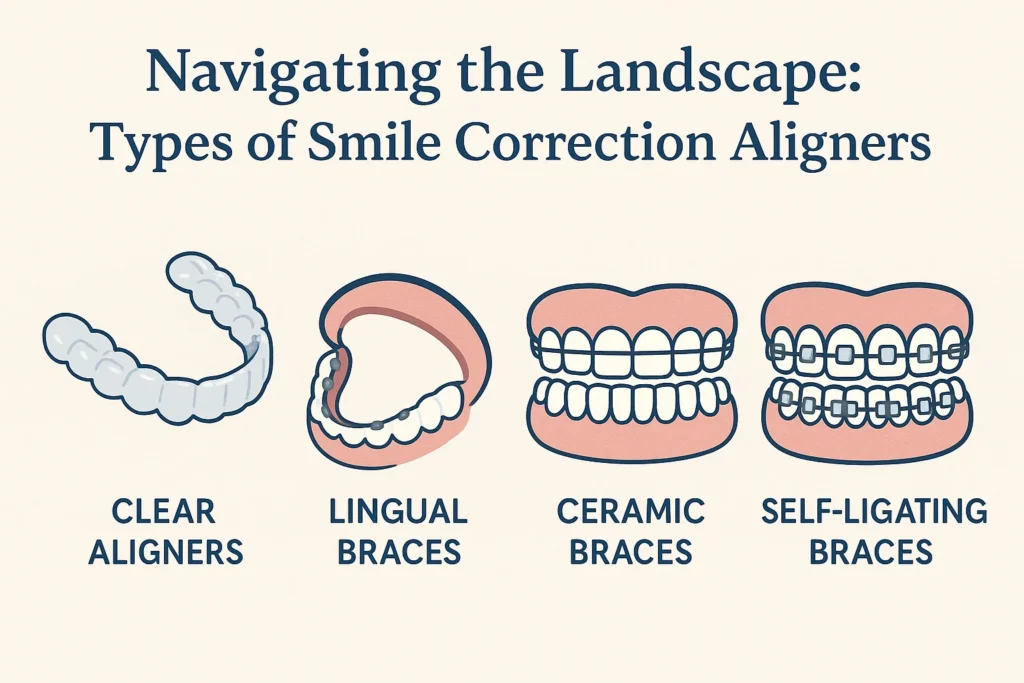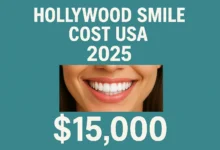Aligners for Smile Correction: A Clear Path to a Beautiful Smile

Aligners for Smile Correction: The Clear Solution for a Perfect Smile
What if the smile you’ve always wanted didn’t require years of metal braces? This is the promise that has made aligners for smile correction one of the most desired dental technologies of the 21 st century. But which of the many brands (Invisalign, at-home impression kits, etc.) is fact, not marketing hype? Take into account another example: it has been estimated that more than 12 million individuals across the globe have worn the clear aligners, but according to a survey conducted by the American Association of Orthodontists in 2024, 34 percent of patients did not realize the limitations of their selected method of treatment.
This definitive guide cuts through the noise. We provide an unbiased, expert-driven deep dive into everything you need to know about using aligners for smile correction. We will discuss how they operate, the comparison of the brands being marketed, the analysis of the real cost, and most importantly assist you in deciding whether this trendy direction is the one that can suit your individual dental objectives. The information seeking begins here.
What Are Aligners for Smile Correction? Beyond the Clear Plastic

In essence, clear aligners are tailor-made, removable orthodontics devices that are manufactured to push teeth to a new orientation over some time. However, not every smile correction aligner is equal. It is the technology behind them that truly makes the difference between a superficial change and one that is deeply fixed in terms of correcting the bite.
The Technology of Tooth Movement: It’s Not Magic, It’s Science
Aligners use the same basic biological principle as conventional braces; constant pressure (controlled) on teeth. This compression generates the process of bone remodelling. The bone on the pressure side undergoes a process of breaking down (resorption) and the other bone forming on the other side (deposition) and this enables the tooth to make safe movements.
Digital planning is where advanced aligner treatment is doing well to enhance smile makeover. Clinicians can map out the complete course of treatment using 3D digital scan of your teeth which is then analyzed using advanced software to show a preview of a virtual smile before and after, a preview of the entire treatment plan. This can be precise in a way that was not possible, and you are planning not only to have straight teeth, but the best occlusion (what your teeth fit together).
What Smile Issues Can Aligners Correct?
Although marketing tends to be simple, the clinical nature is not that straightforward. Aligners are very effective in a variety of problems although their success is based on complexity.
- Superior Candidates: slight or moderate crowding, spacing (gaps), and some forms of crossbites or overbites.
- Moderate Candidates (and in many cases, have to be advanced): Rounded teeth (such as canines) rotations, extruded teeth and other more serious bite problems.
- Bad Applicants (usually need braces or surgery): Huge skeletal discrepancies, huge vertical (deep overbites or open bites) and those that need intrusion of the tooth.
Expert Insight: The most common misconception is that aligners are just for “simple” cases. With today’s technology, like Invisalign’s G8 innovations, we can manage about 90% of the cases that traditionally required braces. The key is a thorough diagnosis by an experienced professional.
Aligners vs. Braces for Smile Correction: The Definitive Comparison
Choosing between aligners for smile correction and traditional braces for smile correction is a significant decision. The best choice isn’t universal; it’s personal, depending on your lifestyle, dental needs, and goals.
| Factor | Clear Aligners (e.g., Invisalign) | Traditional Braces |
|---|---|---|
| Aesthetics | Nearly invisible; a major advantage for adults and image-conscious individuals. | Visible metal brackets and wires. Ceramic options are less noticeable but still visible. |
| Removability | Removable for eating, drinking, brushing, and flossing. This promotes better oral hygiene. | Permanent for the treatment duration. Requires careful cleaning around brackets. |
| Dietary Restrictions | None. You simply remove the aligners to eat whatever you like. | Must avoid hard, sticky, and chewy foods (popcorn, caramel, nuts) to avoid damage. |
| Treatment Control & Precision | Excellent for controlled tipping movements. May struggle with complex root movements without attachments. | Superior control for complex movements, including root parallelism and significant rotations. The “gold standard” for difficult cases. |
| Discomfort | Pressure is distributed evenly, typically causing less mouth irritation. Discomfort is usually temporary with each new aligner. | Can cause irritation to cheeks and lips from brackets and wires. Tightening appointments can cause soreness. |
| Appointment Frequency | Check-ups every 6-10 weeks, as multiple aligners are provided at once. | Adjustments are typically needed every 4-6 weeks. |
So, will Invisalign change my smile as effectively as braces? For most common cases, yes. For highly complex biomechanical needs, braces may still be the more efficient and predictable option.
Navigating the Landscape: Types of Smile Correction Aligners

The market is flooded with options, broadly falling into two categories: professionally supervised and direct-to-consumer (DTC). Understanding this distinction is critical to your safety and results.
1. Professional In-Office Aligners (e.g., Invisalign, Spark)
This is the model which is controlled by orthodontists and dentists. These professionals work with such brands as Invisalign.
- Mechanism of Action: The treatment is under the care of a licensed clinician, toot-to-toot. They scan or take impressions, find out what is wrong, plot the movements of the teeth and keep track of your progress by having you visit them regularly in person.
- Important Advantage: Primary care. The practitioner is able to make corrections along the way, take care of your bite and overcome any unexpected challenges. This is the benchmark of best smile alignment therapy.
- Best Use: This is safe and predictable in terms of results, which is why it is suitable in almost all instances when it comes to situations where a bite correction is needed.
2. Direct-to-Consumer (DTC) Aligners (e.g., SmileDirectClub, Candid)
These companies, like Smile Direct Club, market directly to consumers, often at a lower price point.
- The way it works: You request an impression kit to be scanned at home or you visit a smile shop and scan there. The orthodontists or dentists of the company consult with the case and send aligners to your home with little or no personal supervision.
- Most important Advantage: Cheaper and more convenient.
- Significant Risks: Dysfunctional Diagnosis may not be detected in the background such as gum disease, root problems, or TMJ disorders due to the absence of face-to-face diagnosis. They can only be used in large scale, cosmetic only spacing or crowding. They do not correct bites.
Critical Warning: The American Dental Association has issued statements cautioning against DTC models due to the lack of initial diagnosis and ongoing supervision. Correcting teeth alignment is a medical procedure, not just a cosmetic product. Proceeding without professional oversight can lead to irreversible damage like tooth root shortening or gum recession.
The Real Cost of Smile Aligners: Investment vs. Expense
The question “how much does smile correction cost?” doesn’t have a single answer. The cost of smile aligners varies dramatically based on several factors.
What Influences the Price?
- Complexity and Length of Treatment: A minor crowding treatment that takes a simple 6 months will cost much less as compared to a bite correction treatment that takes 18 months.
- Experience of the Provider: An orthodontic specialist will cost more than a general dentist because of his or her advanced training.
- Geographic Location: It is more expensive in the large metropolitan areas.
Brand of Aligner: Invisalign usually sells at a higher price than other professional brands.
Breaking Down the Numbers: Aligners for Smile Correction Cost
Here’s a realistic range for professional treatment in the United States in 2024:
- Comprehensive Treatment (Invisalign): $3,500 – $8,000+
- Invisalign Lite/Mild (for minor cases): $2,500 – $5,000
- DTC Aligners (e.g., SmileDirectClub): $1,500 – $2,300
Important: The total cost for aligner treatment for smile often includes all related expenses: the aligners themselves, all appointments, retainers post-treatment, and any necessary refinements. Always ask what is included.
Making it Affordable: Insurance and Financing
The treatment of orthodontics in many dental insurance plans will cover part (typically, $1,000 – 2,500) of the treatment of adults. The majority of orthodontic practices also have in-house financing or collaborate with third-party financing organizations such as CareCredit that lets you pay over a number of months or years at no or low interest.
The 5-minute Journey: What to Expect with Aligner Treatment.
When undertaking the aligner therapy as a way of making the smile, it is a commitment. The key to succeeding in this process is to understand the process of consultation to retention.
Step 1: The Diagnosis and Consultation.
This is the most crucial process. A recognized provider will carry out an extensive evaluation, such as digital scanning or impressing, photographs, and in many cases X- rays. This is where they decide whether you are a candidate or not and make a preliminary plan.
Step 2: Your Digital Treatment Fate (Your ClinCheck).
With the help of the scans, your provider develops your tooth movements. You will even have a 3D view of what your projected result will be-your own custom made smile aligners prior and after preview. It is your opportunity to negotiate the plan with your provider.
Step 3: Accepting and Wearing Your Aligners.
When your new custom new smile clear aligners come we will direct you to wear them 20-22hours a day, but only to eat and drink (not water). Another set of aligners will be replaced with another every 1-2 weeks.
Step 4: Continuous Monitoring Implementations.
You will come to your orthodontist after every 6-10 weeks to make sure that your teeth are on the schedule. They can be adjusted early enough in case of minor adjustments that might be necessary.
Step 5: The Retention (The Most Important One)
You are not done with your treatment when you have your teeth in their last position. Teeth possess a memory and will attempt to change. You will be adjusted to a retainer (usually a definite, Vivera-type retainer or a definite wire behind the teeth) that you have to wear as instructed, usually night after night, forever to ensure your best results with the doctor in keeping your smile at its best.
Root Canal Cost USA 2025: What Factors Affect the Price?
Frequently Asked Questions (FAQs)
Do smile aligners work for everyone?
No. Although useful in a broad application, they do not provide a universal solution. Severe bite, severe crowding or those cases that necessitate jaw surgery are more of a better fit to traditional braces. It is necessary to consult the professionals in order to define your candidacy.
What is the pain of smile aligners?
They do not result in pain normally, but there is a period of adjustment. The initial 2-3 days of using a new set of aligners will be characterized by pressure and tightness. This is an indication that the aligners are acted upon. It is not as uncomfortable as tightening of braces.
Can aligners fix an overbite?
Yes, but with a major caveat. Dental overbites (where the teeth are angled wrongly) can also be treated using clear aligners. They are however unable to fix skeletal overbites (where the jawbone is the wrong shape in itself), which might need orthognathic surgery in conjunction with braces.
What is on the red flags of at-home aligner firms?
Look out when the company: does not demand recent X-rays; does not have a face-to-face clinician who will attend to your case; does not have prices that are good enough to be true; does not guarantee anything without a comprehensive diagnosis. Oral health is something that you do not want to take a shortcut on.
What is the average duration of treatment?
The complexity of the treatment dictates the time. Basic cases can be completed within the shortest time of 6 months, and the complex cases require 12-18 months, just like the ordinary braces. The greatest contributor to staying on track is consistency in wearing the aligners throughout the 20-22 hours per day needed to wear.
Your Confident Smile Awaits: Making an Informed Choice
The aligners smile-correcting world presents the adult population and the teens with an unequalled chance to have a healthier and straighter smile without being noticed. Nevertheless, informed decisions are the road to success. The most important lesson is that the aligners themselves can only be considered a tool; it is the skills of the clinician who sets the stage of a safe, healthy, and beautiful result.
And no matter whether it is Invisalign, reviews of Smile Direct Club, or just trying to figure out the cost of smile aligners, the first one is the most important, the thorough consultation with the qualified orthodontic specialist.
Your Next Step: You are ready to be confident about your options? Set up a Free Consultation with our Specialist Orthodontic Unit. We will give you high-tech iTero digital scans and an elaborate treatment strategy, and you will be fully equipped to make the most sound decision regarding your smile.
To keep your results, see our must-have guide to The Importance of Retainers After Invisalign.



